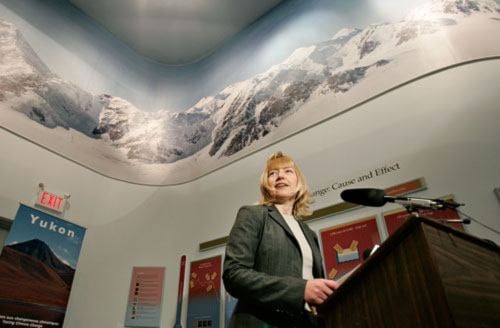Carbon emissions are already degrading Yukon highways, killing Yukon forests and flooding Yukon communities.
On Herschel Island, melting permafrost has begun to expose graves. In the Southern Lakes region, changing weather patterns in 2007 plunged dozens of homes underwater.
By the time today’s kindergarten students graduate from high school, the Yukon government will be completely carbon neutral, promises the Yukon government’s new 45-page climate change action plan.
The plan was announced Thursday by Environment Minister Elaine Taylor.
In 2010, government carbon emissions will be “capped.” By 2015, emissions are slated to drop to 20 per cent below 2010 levels. By 2020, the Yukon government aims to achieve total carbon neutrality.
Achieving total neutrality still has some details to be worked out, said acting Yukon government climate co-ordinator Diane Gunter.
All new government buildings will conform to LEEDs building standards. Government-funded residential construction will meet GreenHome energy standards. All government light vehicles will be made more efficient.
By failing to impose territory-wide emissions standards, the plan offers little vision for the private sector.
“It’s a step in the right direction, I just think we’ll need to make a bigger step,” said climate change specialist John Streicker.
Private incentives for fuel-efficient vehicles are proposed, as well as increased environmental education in Yukon schools, but little else is in place to address what is essentially the
territory’s largest carbon emitter.
The territory becomes locked into a “catch-22,” said Streicker.
“We can’t come up with (territory-wide) targets because we’re not putting resources behind it, and we’re not putting resources behind it because we’re not setting targets,” he said.
A $600,000 climate change secretariat has been established to oversee the government response to what Environment Minister Elaine Taylor called “the No. 1 priority of any Canadian.”
“(The secretariat) lines up all of government, almost like creating a corporate structure, which allows it to work in concert,” said Streicker.
Adaptation is a jewel in the crown of the action plan, said Streicker.
Increased precipitation and harsher freeze-thaw cycles are wreaking havoc on the Yukon’s far-flung road network, prompting a careful examination of maintenance and future construction practices.
Warmer, drier summers burned more forest in the Yukon in 2004 than the rest of Canada combined. A full “health-risk” assessment will determine how best to combat the risk to
Yukon forests from insects, fire and erosion resulting from climate change.
The average Yukoner emits 13 tonnes of carbon dioxide per year, according to a 2005 federal study.
That puts Yukoners at 10 tonnes below the Canadian average, but still higher than the per-capita consumption of other developed nations such as France, Germany, the UK and Italy.
Research will closely follow any government action described by the plan.
“You don’t know where you’re going until you know where you are,” said Gunter.
The territory’s “undisturbed natural ecosystems” — and subsequent vulnerability to temperature changes — have long made it an ideal focal point for climate change researchers, acting as a global barometer for environmental change.
The research is already here, with 83 studies occurring within territorial borders at the time of the plan’s launch. The secretariat aims to better co-ordinate the Yukon disparate
scientific community.
“There are a lot of universities coming up that could be doing individual studies that could really be helped by knowing what else is going on,” said Gunter.
Following the lead of BC, Ontario and Quebec, the plans also calls for a carbon economy; a system to turn carbon emissions into a tradable commodity. Commonly known as a “cap and trade” system, a carbon economy allows “dirty” businesses to meet emissions standards by purchasing from “clean” businesses. As a result, businesses are given direct
financial incentives to become clean.
Similar emissions economies, such as a 1990 plan to reduce acid rain in New England, have found notable success.
Taylor launched the plan in the Beringia Centre rotunda devoted to the environmental consequences of climate change.
Behind reporters, cameras and guests, the fossilized skeleton of a steppe bison stared vacantly at the podium. With the end of the last ice age 11,000 years ago, environmental
changes drove the two-metre-high bison to extinction.
Contact Tristin Hopper at tristinh@yukon-news.com
